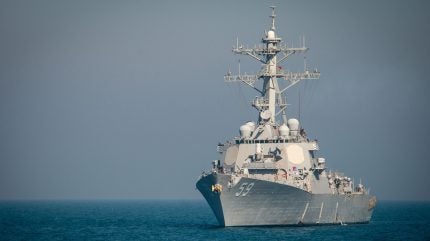
The USS Russell (DDG 59), one of the original Flight I Arleigh Burke-class guided missile destroyers, will spend its 30th year in service undergoing a modernisation programme, to prepare the vessel for its fourth decade of operations.
As the original progenitors of the long-lived Arleigh Burke DDGs, the Flight I variants are all still active despite having been introduced into the US Navy from the early-1990s onwards, and are being kept in service in a bid to maintain surface fleet hull numbers. The USS Russell was commissioned into service in May 1995.
In a 2 December contract announcement, the US Department of Defense (DoD) stated that Continental Maritime of San Diego, based out of San Diego, had been awarded an initial $64m firm-fixed-price contract action for maintenance, modernisation, and repair of USS Russell, under fiscal 2025 docking selected restricted availability.
The DoD stated the contract had been procured using “full and open competition”, with four offers received to perform the overhall programme.
The contract includes options which, if exercised, would bring its cumulative value to $72.6m, with work expected to be completed by June 2026.

According to the US Navy’s March 2024 report to the US Congress on the Annual Long-Range Plan for Construction of Naval Vessels for Fiscal Year 2025, the first of the Arleigh Burke’s, the USS Barry (DDG 52) was proposed to be decommissioned in 2028 after serving its full 35-year operational life.
This is to be followed in 2029 with DDG 54, DDG 55, and DDG 56 (USS Curtis Wilbur, USS Stout, and USS John S McCain respectively), indicating that the USS Russell has a future in the US Navy until 2030 at least.
Evolution of the Flight I-III Arleigh Burke DDGs
As one of the first ten of the original 20 Flight I Arleigh Burke’s (DDGs 51-71), the USS Russell is distinct in having no hangar to house an embarked helicopter, unlike the later Flight IIA and new Flight III vessels.
Official US Navy data explains that the Arleigh Burke-class destroyers replaced the Charles F Adams class (DDG 2), and was designed with an all-new hull form, incorporating much of the Spruance-class (DD 963) destroyer propulsion, and the integrated Aegis Weapons System (AWS) proven on the Kidd-class (DD 993) destroyers and installed on the larger Ticonderoga-class cruisers.
The AWS is composed of a multi-function phased array radar, AAW and ASW systems, VLS, and the Tomahawk cruise missile. The eponymous USS Arleigh Burke (DDG 51) was commissioned in July 1991.
General characteristics, Arleigh Burke guided missile destroyer


The Arleigh Burke-class employs all-steel construction and comprises four separate variants or ‘Flights’, the US Navy states. Within this framework, DDGs 51-71 represent the original design and are designated as Flight I; DDGs 72-78 are Flight II ships; and DDGs 79-124 and DDG 127 are Flight IIA ships.
The Flight III baseline began with DDGs 125-126 and continues with DDG 128 onwards.
According to analysis carried out by the US Congressional Research Service, the US Navy’s FY2024 five-year (FY2025-FY2029) shipbuilding plan, two Flight III Arleigh Burke DDGs are to be built each year during the period.
In September 2023, the US Navy received the first Flight III DDG, the USS Jack H Lucas (DDG 125), introducing new radar capabilities with the AN/SPY-6(V)1 AESA 3D radar, compared to the Flight I and Flight II use of the AN/SPY-1D PESA 3D system. In August 2024, the keel was laid for the fifth Flight III vessel, the future USS William Charette (DDG 130).





